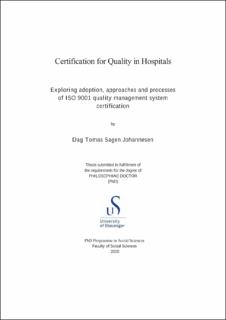| dc.contributor.advisor | Lindøe, Preben Hempel | |
| dc.contributor.advisor | Wiig, Siri | |
| dc.contributor.author | Johannesen, Dag Tomas Sagen | |
| dc.date.accessioned | 2020-10-13T11:51:04Z | |
| dc.date.available | 2020-10-13T11:51:04Z | |
| dc.date.issued | 2020-10 | |
| dc.identifier.citation | Certification for Quality in Hospitals: Exploring adoption, approaches and processes of ISO 9001 quality management system certification by Dag Tomas Sagen Johannesen. Stavanger : University of Stavanger, 2020 (PhD thesis UiS 549) | en_US |
| dc.identifier.isbn | 978-82-7644-957-0 | |
| dc.identifier.issn | 1890-1387 | |
| dc.identifier.uri | https://hdl.handle.net/11250/2682458 | |
| dc.description.abstract | Introduction: ISO 9001 quality management system certification programs are used internationally to ensure, regulate and drive quality improvement in healthcare. Certifications are often described interchangeably with accreditation and positioned within external assessment programs. These external assessments programs are mostly acted by a non-state actor. Globally, the number of hospital certification and accreditation programs has grown tremendously the last two decades. As a governance strategy, it may constitute a move away from the state as the only actor performing regulatory control.
To become certified, hospitals need to adjust their systems to meet the requirements of the ISO 9001 standards. Hospitals are then assessed for compliance with the standard by auditors from an independent certification body and provided with an attestation if they comply. The certification program is intended to assure patients and other stakeholders that hospitals can deliver expected and reliable services. The ISO 9001 standard applies to all sectors and proposes generic requirements for organizational structures and systems to continuously manage and improve quality.
Certification bodies are themselves subject to external assessment by a national accreditation body, according to an international ISO standard. The standard sets requirements for the certification bodies’ system, process and practices to provide ISO 9001 certifications.
Norwegian clinics and hospitals have no clear history for certification or accreditation, despite several initiatives. The first ISO 9001 certification initiatives started almost two decades ago and have been subject to different policy debates. The goal of the government’s National Health and Hospital Plan for 2016−2019 was to introduce a system for quality certification. The ISO 9001 certification was highlighted since it contained many of the same elements for quality improvement as the national internal control regulation. However, no national system has yet been established.
We lack evidence that certification has a direct impact on clinical outcomes, but there are many indicators that certification has fostered organizational change and has positive implications for quality and safety management. We still know little about why health care organizations adopt certification, how
certification processes unfold and are understood, and the methods and approaches used by certification bodies, such as role repertoire, auditor’s conduct (e.g., inspection or guidance) and assessment practice.
Aim: This thesis aimed to develop knowledge about: 1) external drivers and internal processes in hospital certification, by exploring certification processes in hospitals; 2) the scope, understanding and practice of certification processes and the certification regime, by exploring the perspectives of a certification body and the international standards and guidances; 3) the possible contributions to performance improvement from certification processes in hospitals, by exploring characteristics in approaches to ISO certification and examine whether these approaches can support resilience in healthcare.
Method: This thesis consists of two case studies. Case 1 was designed as an explanatory retrospective single-case design study of a first-time ISO 9001 certification process (years 2008-2012) in an emergency department. Data was collected through documentary sources and interviews and analyzed using a narrative approach. A sensemaking framework was applied to explore change processes.
Case 2 was designed as an embedded (multiple units) single-case study. Three units were addressed: 1) auditors’ interaction with hospitals in certification processes; 2) one certification body’s certification approach; and 3) the certification approach in international standards and guidances. Data was collected through documentary sources, interviews, and observations. Theoretical (deductive) thematic analysis was performed to analyze all the data. An auditor typology framework was applied to explore the auditors’ conduct while auditing, and a governance and resilience perspective was adopted to examine certification approaches across units. | en_US |
| dc.language.iso | eng | en_US |
| dc.publisher | Stavanger: Universitetet i Stavanger | en_US |
| dc.relation.ispartofseries | PhD thesis UiS;549 | |
| dc.relation.haspart | Paper 1: Johannesen, D.T.S., Wiig, S. Why adopt ISO 9001 certification in hospitals? A case study of external triggers and sensemaking in an emergency department in Norway. Saf Health 3, 7 (2017). https://doi.org/10.1186/s40886-017-0058-5 | en_US |
| dc.relation.haspart | Paper 2: Johannesen, D.T.S., Wiig, S. Exploring hospital certification processes from the certification body’s perspective— a qualitative study. BMC Health Serv Res 20, 242 (2020). https://doi.org/10.1186/s12913-020-05093-w | en_US |
| dc.relation.haspart | Paper 3: Johannesen, D.T.S., Lindoe, P.H., Wiig, S. Certification as support for resilience? Behind the curtains of a certification body — a qualitative study. In review for BMC Health Serv Res (reviewed and revised) | en_US |
| dc.rights | Navngivelse 4.0 Internasjonal | * |
| dc.rights.uri | http://creativecommons.org/licenses/by/4.0/deed.no | * |
| dc.subject | samfunnssikkerhet | en_US |
| dc.subject | sykehus | en_US |
| dc.subject | sertifisering | en_US |
| dc.subject | ISO-sertifisering | en_US |
| dc.subject | ISO-sertifikat | en_US |
| dc.title | Certification for Quality in Hospitals. Exploring adoption, approaches and processes of ISO 9001 quality management system certification | en_US |
| dc.type | Doctoral thesis | en_US |
| dc.rights.holder | © 2020 Dag Tomas Sagen Johannesen | en_US |

